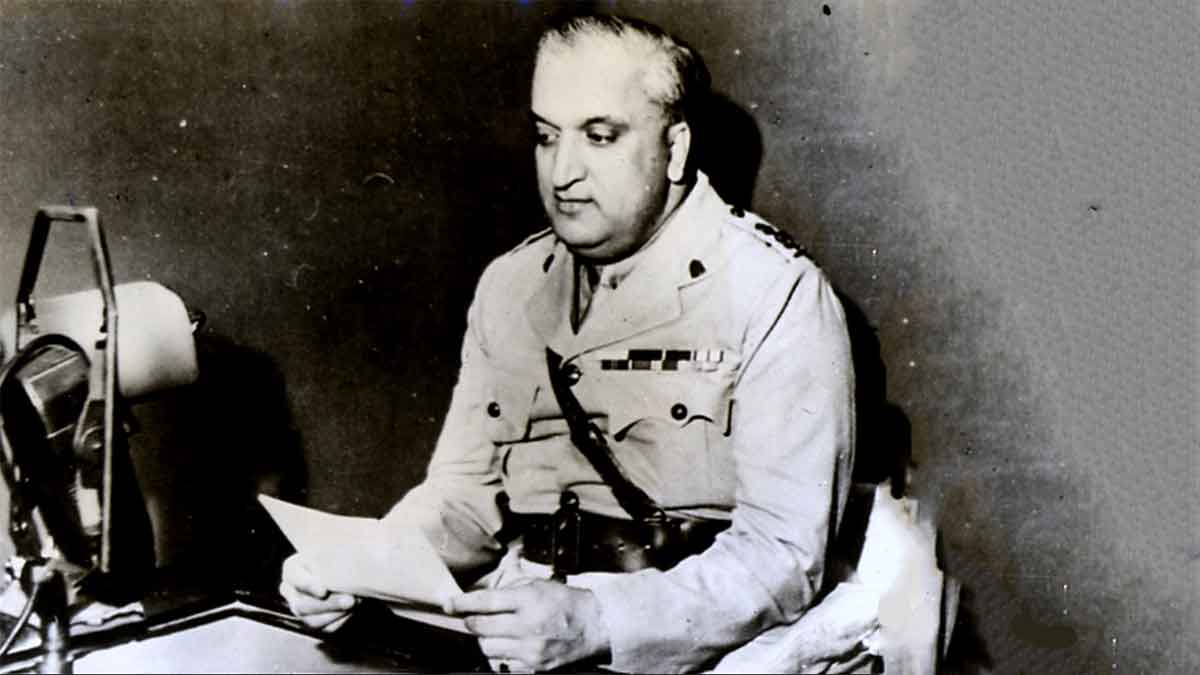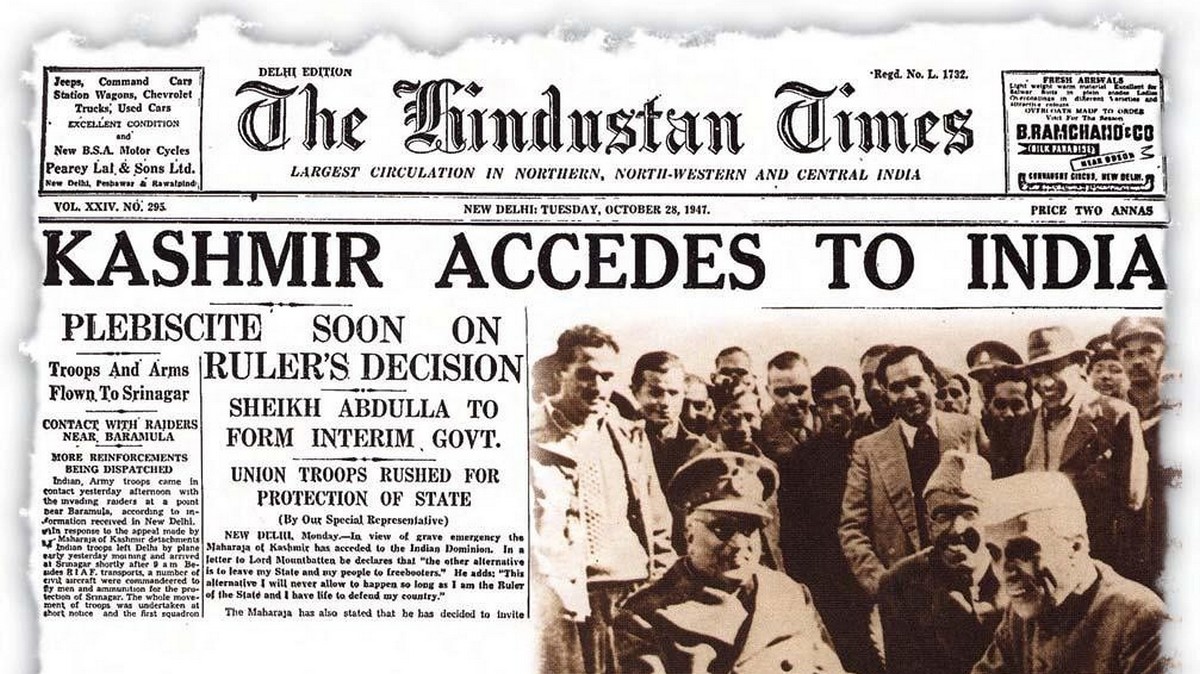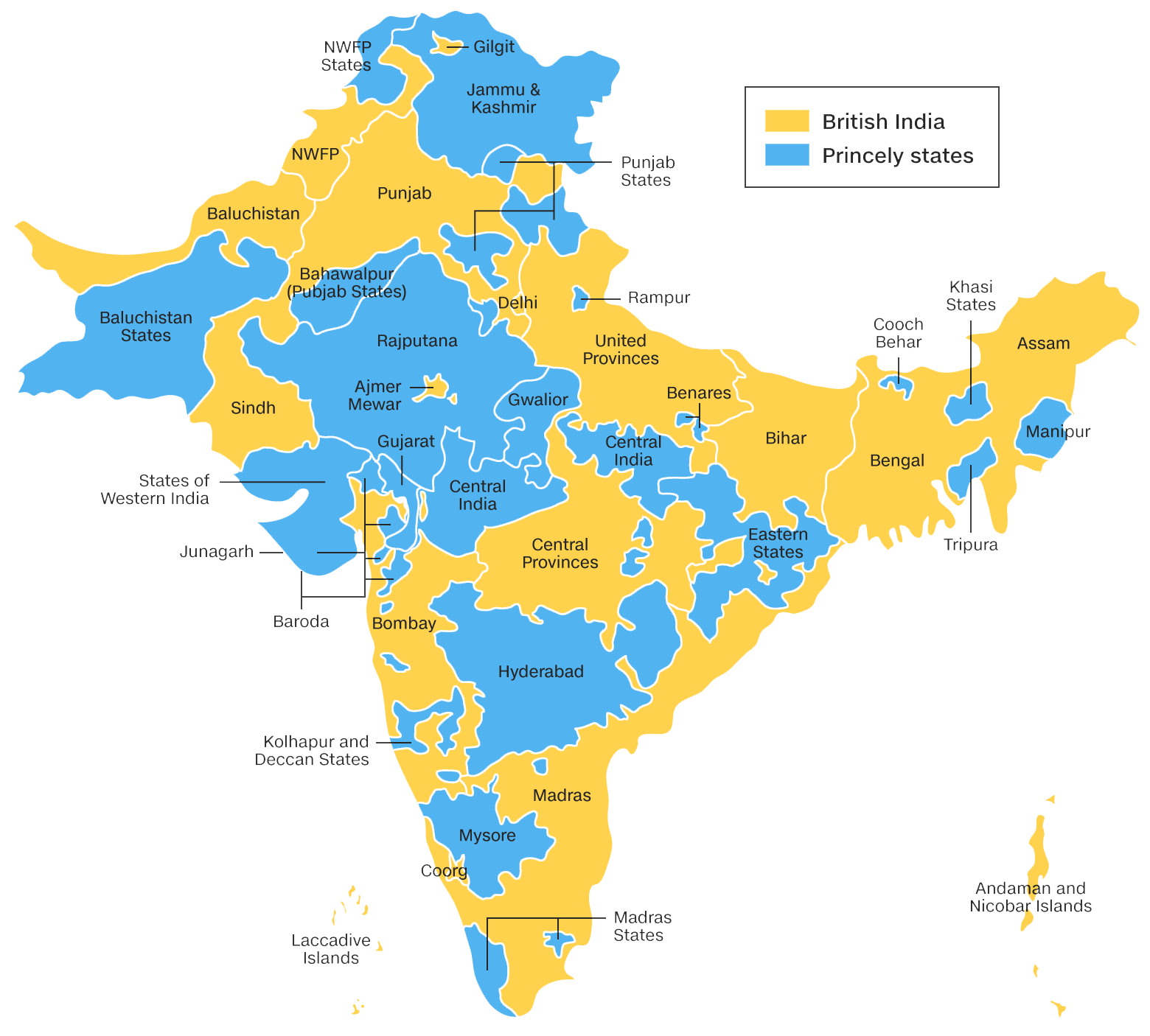India got independent in August 1947. The integration of the Native States was one of the greatest achievements of Independent India. It was a cumbersome task because, without the integration of these Native States, the dream of creating a strong Indian Union would have remained unfulfilled. These native states were spread all over India. These were a total of 562 in number out of these 80 were located within territories allotted Pakistan and the remaining 482 were located within remaining India.
Some of these native states like Hyderabad were very big while some others like Bilbari were very small. The task of integrating these Native States was handled by Sardar Patel, the iron man of India with great perfection.
The Princely States at the time of Indian Independence
British Indian Empire was carved out of Indian National Struggle. Hundreds of these Native States were annexed by the British through wars & battles. The subsidiary alliances system was used by the British to subjugate Indian Native state.
During the period of East India Company, the Native States were under the control of the British Indian Empire but when the company was taken over by the British crown it was emphasized that the Native States were not under British India but they were under the British crown directly. The Governor-General of India was given the additional designation of Viceroy to deal with the Native States on behalf of the British crown.
The Mountbatten plan & Independence of India Act gave three choices to the Native States. These were either they could join India or they could join Pakistan or they could remain Independent. The Independent status of these Native States would have nullified the very purpose of Indian liberation from British rule because Indian Union would have been only bits & piece as National states were 565 in numbers & they were scattered all over India.
Integration of Princely State
The responsibility of integrating National states was handled by Sardar Patel as he was in charge of the home department & department of National states. Sardar Patel was ably supported by his secretary V.P. Menon. To carry out the successful integration of National states, Sardar Patel used a two prompt strategy of persuasion & pressure. This deadly combination of pressure & persuasion enables him to accomplish this herculean task.
Under the strategy of persuasion, nationalist sentiments of National states were aroused. Their contribution to India in past was appreciated & their leadership was sought for the newly emerging Indian Union. Native rulers were promised the continuation of their high status in the Indian Union. It was also guaranteed that their economic interest remained the same; their properties were remained with them & loss of revenue to be compensated through the grant of the Privy Purse.
That Native ruler failed to respond through persuasion then those are threatened by mass agitation & police action They were warned that not only their economic resources would be last but they could also end up in Jail. This strategy based on pressure & persuasion produced the desired result & by 14th Aug 1947, 529 states agreed to sign on the instrument of Accession voluntarily only 3 states were left out & undecided. These were Kashmir, Junagarh, and Hyderabad.
Integration of Kashmir: Instrument of Accession

Kashmir was a border state ruled by Raja Hari Singh. The people of Kashmir as well as their king were in favor of integration with the Indian Union. But Raja Hari Singh was apprehensive that an atmosphere of extreme volatility created by the partition of India could provide an opportunity to Pakistan to disturb the peace. Therefore he sought some time for India & Pak to make his decision.
The government of India respected the desire of Raja Hari Singh but Pakistan tried to annex Kashmir by using force. On 22nd Oct 1947, the Pakistani forces attacked Kashmir by disguising them as local tribal. These invaders carried out the massacre of Kashmir people on large scale. Raja Hari Singh of Kashmir was not in a position to counter this Pakistani invasion. So, on 24th Oct 1947, he requested the Government of India for help.

The government of India refused to interfere in the internal matter of an Independent state. Raja Hari Singh was asked to sign an instrument of Accession after concerning with Sheikh Abdullah– the head of the National Conference. On 26th Oct 1947, the state of Kashmir signed the Instrument of Accession & it was formed in Kashmir with Sheikh Abdullah as its head.
On 27th Oct 1947, Indian forces were airdrops in Kashmir to counter Pak invaders. By the end of Dec 1947, 2/3rd of Kashmir was successfully liberated by Indian forces. So by 1st Jan 1948, Indian PM Jawaharlal Nehru was pressurized by Governor-General Lord Mount Batten to take the issue of Kashmir to United Nations Organization. India was expecting that the United Nations Organization will impartially decide the issue but since the cold war was already was going on United Nations could not take an Independent state.
In 1950, the United Nation Commission on Kashmir submitted its award which was revolving around three main points, Pakistan should withdraw its forces from the territory of Kashmir under its control, India should remove the bulk of its forces from Kashmir, and a plebiscite should be held in Kashmir to understand the desire of Kashmir.
Pak Government rejected this United Nations award, India agreed to hold a plebiscite but since Pakistan refused to withdraw its forces from Pak. The Plebiscite couldn’t be held. The issue of Kashmir is still alive, even after 3 wars having been fought between Indo-Pak over the same.
Integration of Junagarh: Plebiscite in Favor of India
The state of Junagarh was ruled by Muhammad Mahabat Khan III. In spite fact that most citizens of Junagarh were strongly in favor of joining the Indian Union, Nawab wanted to join Pakistan. There was no contiguous land border between Junagarh & Pakistan. But there was open access through the sea. In Sept 1947, Nawab declared his intention to join Pakistan; a mass revolt broke out immediately. The Nawab fled to Pakistan.
On 8th Nov 1947, Diwan of Junagarh, Shah Nawaj Bhutto wrote a letter to the Government of India requested that India should take over the administrative responsibilities of Junagarh. On 9th Nov 1947, the Government of India took over the admin of Junagarh & this state became part of the Indian Union. Since the ruler of Junagarh had not signed any instrument of accession, a plebiscite was held on 20th Jan 1948 to understand the desire of the people.
In this plebiscite, 80000 to 1lac voters favored integration with Indian Union & only 91 supported joining Pakistan. Local people movements known as Arzi Hukumat-e-Azad Hind led by Samaldas Gandhi played important role in the success of popular revolt in the state of Junagarh.
Integration of Hyderabad: The Operation Polo
The state of Hyderabad was ruled by Nizam Osman Ali Khan. Even though the majority of people of Hyderabad were in favor of joining the Indian Union, Nizam was harboring the dream of joining Pak. He made every possible effort to find a way to join east Pak but in absence of a contiguous land border. This plan couldn’t succeed. After failing in finding a way to join Pak, Nizam of Hyderabad tried to maintain the status of an independent state.

The demography of Hyderabad was the biggest obstacle in the way of the Independent status of Hyderabad. Around 87% of people were Hindus, because of this overwhelming Hindu majority, it was clear that plebiscite would in favor of joining India. To counter this challenge, Nawab planned a demographic transformation of the state.
A private militia known as “Razakar” was raised under the leadership of Qasim Razvi. Razakar was giving free hand to push Hindu’s out of Hyderabad so that favorable vote could be ensured. Lakhs of poor Hindu peasants were forced out of Hyderabad. Their crops were destroyed & houses were burnt. Large scale exit of people from Hyderabad created a very serious humanitarian crisis in the neighboring state of Madras.
When this crisis reached beyond manageable proportion, the government of India had to undertake a police action code name operation “Polo”. Indian forces entered into Hyderabad on 13th Sept 1948. By 18th Sept 1948, Hyderabad was under Indian control. On 22nd Nawab agreed to integration of Hyderabad with the Indian union.

